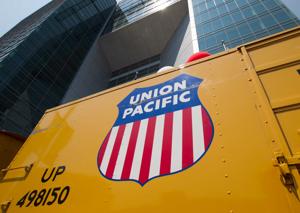Comments:
Note the secrecy here, from both the Union Pacific and the Federal Railroad Administration (more a servant of than a regulator of the industry).
In the course of fighting a proposal for an LNG terminal in New Jersey, we learned a lot about the hazards of LNG. Unit trains of this would make crude oil look benevolent by comparison.
The Union Pacific provides these maps of its system in Minnesota and Wisconsin.
Could this be a foot-in-the-door for trains even more dangerous than the oil (bomb) trains?
am
Union Pacific Railroad has applied for permission to haul liquefied natural gas, which would add another combustible cargo to a U.S. rail network already being criticized for transporting ethanol and crude oil through populated areas.
The Omaha-based railroad said the application for a permit from the Federal Railroad Administration is in response to a request for liquefied natural gas transportation from an existing customer. Union Pacific operates 32,000 miles of track in the western United States, which is home to many natural gas production and storage installations.
If Union Pacific is granted the permit, it would be a first. The Association of American Railroads said none of the six other Class I freight railroads are hauling liquefied natural gas.
The permit application coincides with a major bump in railway ethanol and crude oil cargo, which has attracted heavy opposition after a fatal oil train explosion in Canada in 2013 and three oil train fires so far this year in the United States and one in Canada.
“The timing for U.P. is awkward given recent accidents and mounting public apprehension,” said Joseph Schwieterman, a transportation sciences professor at Chicago’s DePaul University. “I am sure there will be pressure for a go-slow approach on it, but the fact is that railroads are the best bet to get significant amounts of natural gas to market given the decades it takes to permit and construct pipelines.”
Details about the application are secret. A Federal Railroad Administration spokesman said application and supporting materials are not available for public inspection during the review process. “Federal law limits our disclosure” of which customer is requesting transport of liquefied natural gas, Union Pacific spokesman Aaron Hunt said.
Liquefied natural gas, or LNG, however, is a well-known commodity. Liquefying the fuel — which most often moves via pipeline, truck and ship — compacts it enormously. That makes it attractive to shippers and those who want to store large quantities. Liquefied gas takes up 1/600th the space of the gaseous form. The liquid gas can then be converted back into its gaseous state for use or further shipment in pipelines.
Union Pacific’s permit request comes as U.S. natural gas production is climbing, up 37 percent since 2000. Part of the boom is the conversion of coal-burning electric plants to natural gas. There also are 128,000 vehicles in the United States running on compressed natural gas, up 12 percent since 2010.
“It has only been a matter of time for the railroads to get in on the natural gas boom,” Schwieterman said. “It is a fast-growing industry with fast-growing logistical needs.”
But some people are holding back. Eddie Scher, an officer with ForestEthics, a California-based lobbying group that advocates the gradual elimination of fossil fuels, said that transporting another flammable cargo on the rail network is a very poor idea.
“The rail system in America was built to connect population centers, with trains going through every downtown in the country,” Scher said. “It was never designed to haul hazardous materials, and in fact, you could say that if you were to design a rail system for hazardous materials, the one we have is the opposite of the one you would design.”
Scher said federal safety rules are already out of date for oil trains and their tank cars, with millions of gallons of oil a day riding the rails, up from nearly zero only five years ago, courtesy of skyrocketing production from new fields in Montana and North Dakota.
“To entertain the idea of new and potentially more dangerous cargo makes no sense at all,” Scher said.
Hauling dangerous cargo is nothing new for Union Pacific and other railroads, which haul chlorine, explosives and sulfur.
Safety is a main point of emphasis for every cargo, said Hunt, the Union Pacific spokesman. The national train accident rate has fallen 42 percent since 2000 and 79 percent since 1980, according to the railroad association. At Union Pacific, derailments have fallen about 7 percent since 2010, to three for every million miles of train travel.
“We have the same goal as everyone else, and it’s in the best interest of our customers, shareholders and the communities where our employees and their families live, work and play to operate as safely as possible,” Hunt said.
Contact the writer: 402-444-3197, russell.hubbard@owh.com


No comments yet.